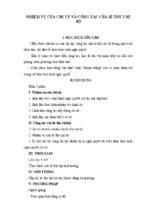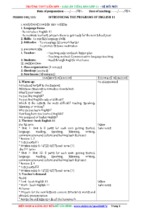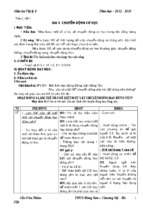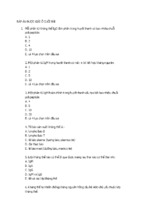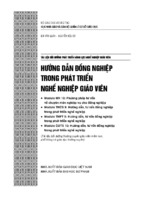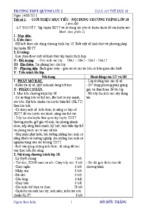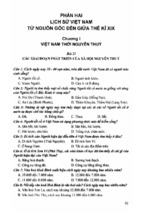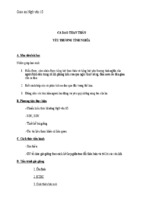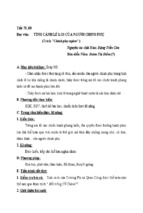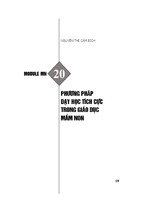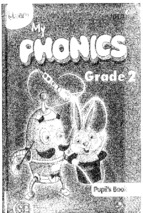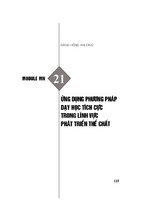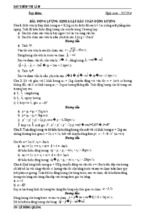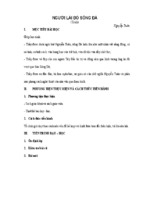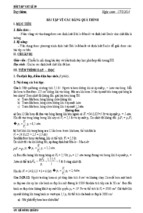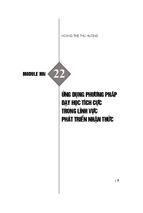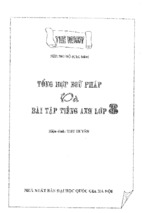Date of preparing: 1/8/2013
Week: 1
Period: 3
LESSON 1: READING
I. AIMS: Training Ss to improve reading skillS: guessing meaning in context, scanning for
specific information and reading to get information about daily routine of farmers.
II. OBJECTIVES: By the end of this lesson, students will be able to read better through Multiple
choice and questioning exercises.
III. TEACHING AIDS: textbooks and handouts…
IV. PROCEDURE:
Stages & Content
A.WARM – UP: Matching
A
B
1. a teacher
a. does homework
2. a doctor
b. works in the field
3. a student
c. delivers letters
4. a postman
d. looks after patients
5. a farmer
e. gives lessons
Questions:
T : What does a teacher do?
S1 : He gives lessons.
T : What does a doctor do?
S2 : He looks after patients.
.........
T : What does a farmer do?
S5 : He works in the field.
B. PRE – READING:
Before you read:
T: What time do you often get up?
….
Pre-teach vocabulary:
- plough (v) ( the action of the man in
the picture) cày
- 'harrow (v) : bừa
- a plot of land (n) thửa ruộng
- 'peasant (n) : a poor farmer
- pump(v) : bơm
- trans'plant (v)( use 2 words"plant" and
"trans-" to explain). Cấy
do the transplanting
T’s activities
- Ask sts to close their books
- Deliver handouts, and ask sts to match a
noun in column A with a phrase in column
B.
- Ask ss to match quickly in one minute,
then ask some ss to stand up to answer T's
questions.
- After the last question, T introduces the
new lesson.
- Listen and do the task.
- Repeat.
- Copy.
Checking vocabulary (ROR)
- Ask sts to open their books and look at
"Before you read" , explain what they are
going to do.
- Do the first example.
- Ask sts to work in pairs to ask and
Ss’ activities
- Close their
books
- Match two
columns
- answer T's
questions.
answer about their daily routine, using
the cues in the textbook.
- Ask them to work in 3 minutes,
meanwhile T moves round to help if
necessary.
- Ask some pairs to report .
- Ask sts to look at the picture in the
textbook and guess the man's job.
- Introduce the topic of the reading
passage: " A day in the life of a farmer"
- Introduce some new words
- Ask questions and other techniques to
elicit new vocabulary.
- Say each word 2 times.
- Call Ss to repeat in chorally and
individually. Ask them to copy.
As
C. WHILE – READING:
+ Task 1:
Choose the option A, B or C that best
suit the meaning of the italicised
words.
Answers:
1. C
2. C
3. A
4. A
+ Task 2:Answer the questions
Answers:
S1: What is Mr. Vy's occupation?
S2: He is a farmer.
S3: What time does he get up and what
does he do after that?
S4: He gets up at 4.30, then he goes
down to the kitchen to boil some water
for his morning tea.
S5: What does he do in the morning?
S6: In the morning he ploughs and
harrows his plot of land, drinks tea and
smokes local tobacco during his break.
S7: What do Mr. Vy and his wife do in
the afternoon?
S8: They repair the banks of their plot of
land. Mr. Vy pumps water into it while
his wife does the transplanting.
S9: Are they happy with their lives or
not? Why?
S10: Yes, they are. Because they love
working and they love their children.
- Ask sts to read the passage about a
farmer, Mr. Vy and his wife, Mrs. Tuyet.
and do Task1.
- Ask sts to work individually in 5 minutes
to do this task.
- Guide sts to read through the passage ,
then focus on only the sentences
surrounding the italicised words to do the
task effectively.
- Ask them to share their ideas with their
parners.
- Ask 4 sts to stand up to answer , then give
remarks.
- Translate the words in case sts do not
know
- Ask sts to read the passage again and
answer the questions about Mr. Vy and Mrs.
Tuyet.
- Ask them to work in pairs , one asks and
one answers.
- Move round to make sure that all sts are
working and to help them if necessary.
- Ask some sts to report and give feedback .
- Individually.
- Take notes.
- Work in
pairs
D. POST – READING:
Work in groups. Talk about Mr. Vy nad
Mrs. Tuyet’s daily routine
E. HOMEWORK:
- Translate the passage into Vietnamese.
- Prepare for next period – Speaking.
- Ask sts to close their books.
- Work in
- Ask them to work in small groups of three groups.
or four to talk about Mr. Vy and Mrs.
Tuyet's daily routines
- Encourage them to use their own words.
- Ask one or two pairs to report.
- Give homework
- Listen &
take notes.
Date of preparing: 2/8/2013
Week 2
Period: 4
LESSON 2: SPEAKING
I. AIMS: Training Ss to improve speaking skill.
II. OBJECTIVES: By the end of this lesson, students will be able to work in pairs to ask and answer
about one's daily activities using a timetable or pictures and they can talk about their daily routines.
III. TEACHING AIDS: textbooks and handouts…
IV. PROCEDURE:
Stages & Content
A.WARM – UP:
A
B
1. Civic education
a. To¸n häc
2. Technology
b. VËt lý
3. Maths
c. Tin häc
4. Literature
d. ThÓ dôc
5. Physics
e. §Þa lý
6. Biology
f. Gi¸o dôc CD
7. Chemistry
g. V¨n häc
8. Physical education h. LÞch sö
9. Geography
i. C«ng nghÖ
10. History
j. Sinh häc
11. Informatics
k. Ho¸ häc
Answers: 1-f ; 2-i ; 3 - a; 4 - g; 5 - b; 6 - j;
7 - k; 8 - d; 9 - e; 10 - h; 11 - c.
B. PRE – SPEAKING:
Review structures of the present simple and
the way of telling time.
Ex: 7.30: seven thirty or half past seven
...
T’s activities
- Ask sts to close their books.
- Deliver the handout.
- Ask them to match one item in
column A with one item in column B.
- Ask them to work in groups in 2
minutes, then check this exercise in
chorus.
- Ask sts to read aloud the names of
these subjects in chorus.
- Introduce briefly what sts are going
to do in this lesson.
- Ask sts about the verb tense to use in
talking about daily routines.
- Remind sts of some rules of the
present simple tense.
- Recall the way of telling time.
- Write some more examples and ask
Ss’ activities
- Group work
- Listen and
answer.
sts to read aloud.
+ Task 1: Quan is a tenth-grade student. He
goes to school every morning. Now, look at
his weekly timetable ask and answer
questions by using the information from the
timetable.
T: What time does Quan have a Civic
Education lesson on Monday?
S: He has a Civic Education lesson at
7.15a.m
T: What lesson does Quan have at 7.15 a.m
on Monday?
S: At 7.15 on Monday he has a Civic
Education lesson.
- Ask sts to open their books.
- Introduce the requirement of the
task.
- Ask sts to look at the timetable in the
textbook and read through it.
- Do the first example with a student.
- Ask the whole class to read these
sentences again.
- Ask two pairs to read again.
- Ask sts to work in pairs in 10
minutes to ask and answer about Quan
basing on the timetable.
- Move round to help sts and to correct
any mistakes if there are.
- Ask some pairs to report
- Listen and give remarks.
- Open the
textbook.
- Listen to the
teacher.
- Look at the
timetable and try
to understand it.
- Work in pairs
+ Task 2:
- " Quan is at school in the morning, and
what does he do in the afternoon? Please
look at pictures in task 2"
T: ( look at picture 1) What does Quan do at
2.00 p.m?
Answer: Quan gets up at 14:00 p.m. At
14:15p.m he studies or reads books. At
16:30p.m he watches TV. Then at 17:00p.m ,
he cycles to the stadium and plays football
with his friends at 17:15 p.m. At 18:30p.m he
returns home. At 18:45, he takes a shower,
and he has dinner with his family at 19:00
p.m. At 20:00p.m he does his exercises.
- Introduce task 2
- Ask sts to work in pairs to ask and
answer about Quan's activities.
- Do the first example.
- Ask sts to work in the same way,
remind sts to use the present simple
tense with the third person.
- Move round to control the activity
and to help sts if necessary.
- After sts have discussed, ask a
student to talk about all Quan's
activities in the afternoon.
- Look at pitures in
task 2 and think of
the phrases to talk
about Quan's
activities.
- Work in pairs
C. WHILE – SPEAKING:
D. POST – SPEAKING:
+ Task 3:
Tell your classmates about your daily
routine.
E. HOMEWORK:
- Write a paragraph ( about 80 words) about
your daily routines in workbook.
- Prepare the new lesson: LISTENING
- Ask sts to think about themselves,
and then work in small groups to tell
their friends about their daily routines.
- Remind sts that they are using the
present simple with the first person.
- Move round to check the activities
and to make sure that sts are working
effectively.
- Ask one or two sts to report in front
of the whole class.
- Check and give remarks.
- Give homework
- Work in groups
- Think about theit
daily activities and
talk to their
friends.
- Try to use
English to talk.
- Listen & take
notes
Date of preparing: 3/8/2013
Week 2
Period: 5
LESSON 3: LISTENING
I. AIMS: Training Ss listening skill for specific information about daily routines.
II. OBJECTIVE: By the end of the lesson, Ss will be able to listen to get the information through
the exercises: True/False statement and ordering exercises.
III. TEACHING AIDS: handouts, textbook and cassette.
V. PROCEDURE:
Stages & Content
A.WARM – UP:
Some suggested answers:
- train, coach, bus, car…
- motorbike, bicycle
- cyclo, taxi…
B. PRE – LISTENING:
T’s activities
Ss’ activities
- Ask ss to work in groups - Work in
and make a list of vehicles groups.
and the people who operate
them, then compare their list
with other groups’
- Introduce the topic of the
listening text: ‘A day in the
life of a cyclo driver’ and ask
ss to open their books.
- Ask sts to work in pairs to - Pair work
ask and answer the questions
in the textbook.
- Move around to help sts
then ask some pairs to report.
- Ask S to look at the words
in the book and read after T .
- Introduce some new words - Listen &
- Read the words aloud and take notes.
Pre-teach vocabulary:
asks sts to repeat.
- 'passenger (n): (in the pictures)
- Ask some sts to read the
- 'district (n): e.g.: Ba Dinh district, Thanh Mien words again.
district
Work in pairs to ask and answer the questions in the
textbook
Have you ever traveled by cyclo?
When was it?
Is it interesting to travel by cyclo?
Which do you prefer, going by bicycle or by cyclo?
Give reasons.
- drop (v): when the passenger gets off the cyclo.
- 'pedal (v) = cycle (v)
- 'purchases (n) = the shopping: The things someone
has bought
- food stall (n) : (In the picture) a place to have
lunch…
C. WHILE – LISTENING:
+ Task 1: listening and ordering pictures.
Keys:
1. e 2. f 3.a 4.c 5.b 6.d
+ Task 2:
Listening for specific information by deciding if the given
statements are true or false.
Keys:
1. F 2. T 3. F 4. F 5. F 6. F
D. POST – LISTENING:
Ask and answer questions about Mr. Lam’s activities.
- Ask ss to work in pairs,
look at the pictures in the
textbook and describe each
picture.
- Do the first example:
In the first picture, a cyclo
driver is cycling his cyclo
and taking a woman to
somewhere.
- Introduce the situation
about Mr. Lam, a cyclo
driver in Hochiminh city
talking about his daily
routines. Ask ss to listen to
the tape/ teacher and number
the pictures in the correct
order.
- Play the tape/ read the text
twice.
- Ask ss to share their
answers in pairs.
- Get sts’ answers.
- Play the tape once again,
stop where necessary and
conduct the correction.
- Ask ss to have a look at the
statements and read them in
pairs and make sure they
understand the statements.
- Ask sts to listen to the
tape/T again and tick the box
to indicate if the statements
are true or false.
- Ask sts to compare their
answer in pairs.
- Checks sts’ answers.
- Play the tape once again,
stop where necessary and
conduct the correction.
- Ask sts to work in pairs and
use the suggested words to
ask and answer about the
cyclo driver.
- Move round to check the
activities and to make sure
that sts are working.
- Ask one or two sts to retell
- Look at the
pictures in the
textbook and
describe each
picture.
- Listen
carefully.
- Share
answers with
partner.
- Correct.
- Read the
statements.
- Listen
- Pair work
- Correct
- Pair work.
the cyclo driver’s routines in
front of the whole class.
- Check and give remarks.
E. HOMEWORK:
- Write a story paragraph about 50 words about Mr. Lam's
routines
- Prepare for the next lesson WRITING.
- Give homework.
- Listen &
takes notes.
Date of preparing: 3/8/2013
Week 2
Period: 6
LESSON 4: WRITING
-
I. AIMS: Training Ss writing skills about how to write a narrative using the prompts.
II. OBJECTIVE: By the end of the lesson, Ss will be able to:
Read a passage to find the verbs in the past simple and the connectors.
Write a narrative using the prompts.
III. TEACHING AIDS: poster and textbook.
IV. PROCEDURE:
Stages & Content
A.WARM – UP:
T: What is happening ?
T: Do you know where it happened?
T: When did it happen?
T: How did it happen?
Answers: The buildings are on fire. It happened in the
U.S.A. It happened on September 11th , 2001. Two planes
carrying bombs crashed into two buildings and killed a lot
of people.
T’s activities
Ss’ activities
- Show a picture that
Listen and
teacher prepared in
answer the
advance about the
questions.
explosion in Twin
Towers in 2001.
- Ask some questions
- Tell sts that they are
going to write a
narrative of past events.
B. PRE – WRIRING:
Pre-teach vocabulary:
Stare death in the face : đối diện với tử thần
Take off >< land: cất cánh >< hạ cánh
In danger : gặp nguy hiểm
Relieved : yên tâm
Frightening : khủng khiếp
Be crowded with : đông đúc
Fire brigade : đội cứu hỏa
Choke: nghẹt thở
Cough : ho
Task 1: Read the passagein the textbook and find all the
verbs that are used in the past simple and the connectors in
the story.
- Teach some new
words.
- Listen &
take notes.
- Ask sts to look at
Task 1 .
- Ask them to read
- Listen
- Read
through the
Answers:
+ Verbs used in the past simple: stared, was, arrived, got,
took off, began,thought, were told, seemed, realised, were,
screamed, thought, had, felt, gained, announced, landed.
+ Connectors( expressions of time): on that day, at first,
then, a few minutes later.
Task 2:
Work in groups. Identify the events, the climax, and the
conclusion of the story.
Answer:
+ The events: people got on plane, plane took off, hostesses
were just beginning to serve lunch when plane began to
shake, plane seemed to dip, people screamed in panic.
+ The climax: We thought we had only minutes to live.
+ The conclusion: the pilot that everything was all right, we
landed safely, it was the most frightening experience of my
life.
A narrative:
+ Form: 3 parts: - introduction.
- body: events, climax
- conclusion
+ Verb tense: the past simple tense.
+ Connectors: at that time, on that day,then, after that, a
few minutes later, until, etc.
C. WHILE – WRITING:
Task 3:
Use the prompts to build up a narrative about a hotel fire.
(Textbook, page 18)
D. POST – WRITING:
Last year I spent my summer holidays at a seaside town.
The hotel was modern and comfortable. I had a wonderful
holiday until the fire.
It was Saturday evening and everyone was sitting in the
through the passage in
two minutes to get the
main idea.
- Ask one student to
report.
- Ask sts to listen and
read these words again.
- Ask them to read the
passage again more
carefully and do task 1
in 5 minutes.
- Move round to make
sure that all sts are
working.
- Ask them to share
their answers with their
partners.
- Check the task by
asking two sts to report.
- Give remarks.
- Ask sts to read the
passage again and in
groups to do task 2.
- Divide the class into
three regions: one
identifies the events,
one identifies the
climax and the rest
identifies the
conclusion.
- Ask sts to work in
only 2 minutes.
- Ask three
representatives of three
groups to report.
- Draw the conclusion
about writing a
narrative.
passage to
get the main
idea.
- Explain the
requirement.
- Ask them to work
individually.
- Move round to
conduct the activity and
to note down sts'
mistakes.
- Ask sts to share their
answers with their
partners.
- Ask sts to report their
work by sentence. Give
feedback.
- Remind sts that they
should use the past
- Listen.
- Write the
passage into
their drafts.
- Work
individually
to do task 1.
- Listen
- Work in
groups.
- Listen and
take notes.
- Listen
- Copy into
their
notebook.
discotheque on the ground floor.
It was crowded with people. They were dancing and singing
happily. Suddenly we smelt smoke. Then black smoke began
to fill the room. Everybody started to scream in panic.
People ran away toward the fire exits. One door was
blocked. Many people began to cough and to choke.
Then just as we thought we had only minutes to live, the fire
brigade arrived. Firemen fought their way into the room
and soon everyone was safely out of the building. Luckily,
nobody was seriously hurt. It was the most frightening
experience of my life.
E. HOMEWORK:
- Rewrite the paragraph at home, prepare for the next period
simple to write.
- Give homework
- Listen.
Date of preparing: 4/8/2013
Week 3
Period: 7
LESSON 5: LANGUAGE
FOCUS
I. AIMS: Training ss Students to improve pronunciation skill and grammar.
II. OBJECTIVES: By the end of this lesson, students will be able to:
- Distinguish and pronounce the sounds /I/ - / i:/ exactly.
- Revise the present simple with adverbs of frequency and the past simple.
III. TEACHING AIDS: textbooks, handouts.
IV. PROCEDURE:
Stages & Content
A.WARM – UP:
B. PRONUNCIATION:
* Presentation 1:
- / i: / open your mouth very little to make the
sound/ i: /, is a long sound
- /I/ First practice the sounds / I: /. Then open
your mouth a little more, is a short sound.
* Practice 1:
Listen and repeat: (page 19)
Practise these sentences: (page 19)
C. GRAMMAR AND VOCABULARY:
* Presentation 2:
I. The past simple
T’s activities
Ss’ activities
- Draw the pictures of a sheep and
a ship on the board. Ask ss what
they are in English.
- Ask them to identify the
difference in pronouncing those
words. Introduce the new lesson.
- Listen
- Help Ss to distinguish these two
sounds.
- Play the tape and ask Ss to
repeat.
- Pay
attention
- Divide class into 2 groups to
practise in turn between 2 vowels.
- Ask Ss to practise in pairs.
- Read these sentences.
- Call some Ss to read and give
feedback.
- T reminds the uses and the
- Practise.
- Read.
- Listen, take
+ Form: (+ ) S + V-ed/ V( irregular) +........
( - ) S + didn't + V +..........
( ? ) Did + S + V + .............?
+ Use: to indicate that somthing happened in the
past.
+ Signs: Yesterday , last year , last night, ago, in
1998, in 18th century ....
II. The present simple
+ Form: (+) S + V/ Vs/ Ves +.......
(- ) S + don't/ doesn't + V +......
(?) Do/ Does + S + V +..........?
+ Use: to talk about present habits or present
states.
+ Signs:
forms of the simple present and
the simple past tenses; and some
adverbs of frequency
- Individual &
pair work.
- each, every, once a week, twice a week…
- Adverbs of frequency: always, usually,
often…( Position: after " to be" but before other
verbs; between auxiliary verbs and main verb;
" As a rule" is placed at the beginning of a
sentence.)
* Practice 2: Exercise 1 (page 19, 20)
Complete the sentences using the + one of the
adjectives:
Key:
1. is
7. catch
2. fish
8. go
3. worry
9. give up
4. are
10. say
5. catch
11. realise
6. am
12. am
* Practice 3: Exercise 2(page 21)
Sample answers:
He always get up early.
She is sometimes late for school.
Lan normally practises speaking English.
As a rule, Thao is a hard- working student.
* Practice 4: Exercise 3 (page 21)
* Answer:
1. was done
7. began
13. was
2. cooked
8. felt
14. leapt
3. were
9. put out
15. hurried
4. smelt
10. crept
16. found
5. told
11. slept
17. wound
6. sang
12. woke
18. flowed
D. HOMEWORK:
- Practise all structures again and completely.
- Prepare Unit 2 lesson 1 READING.
notes
- Ask Ss to work
individually and do exercise 1 in
the book.
- Have Ss compare their answers
with a friend.
- Give feedback.
- Ask sts to do Ex 2 orally in pairs
in 2 minutes.
- Move round to conduct the
activity.
- Ask 2 sts to report.
- Whole class.
- Pairwork.
- Ask sts to look at Ex 3 and
explain what sts are going to do.
- Ask sts to do this exercise in 5
minutes , then share their answers
with their partners.
- Ask them to pay attention to the
past form of irregular verbs and
some verbs are put in passive
voice.
- Ask 2 sts to do this exercise on
the board.
- Move round to help sts if
necessary.
- Check and give remarks.
- Work
individually,
then in pairs.
- Give homework.
- Listen and
take notes.
Date of preparing: 5/8/2013
Week 3
Period: 8
LESSON 1: READING
I. AIMS: Training Ss to improve reading skillS: guessing meaning in context, scanning for
specific information and reading to get information.
II. OBJECTIVES: By the end of this lesson, students will be able to read better through gap –
filling and questioning exercises.
III. TEACHING AIDS: textbooks…
IV. PROCEDURE:
Stages & Content
A.WARM – UP:
Question: when you meet your friends,
which of the following topics do you
often talk about?
- sports and games
- entertainment
- health problems
- hobbies
- holiday
- films
- weather
- work and study
B. PRE – READING:
Pre-teach vocabulary:
+ corner shop(NP): cửa hàng ở góc phố
+ profession(n): việc làm, nghề
+ stuck(adj): bị tắc
+ attitude(n): thái độ
+ mall (n): trung tâm mua sắm
Checking vocabulary: ROR
As
C. WHILE – READING:
T’s activities
- Ask sts to close their books
- Ask them to answer the question and write
down on the board.
- After that, T introduces the new lesson.
- Introduce some new words
- Ask questions and other techniques to
elicit new vocabulary.
- Say each word 2 times.
- Call Ss to repeat in chorally and
individually. Ask them to copy.
Ss’ activities
- Close their
books
- Answer T's
questions.
- Repeat.
- Copy.
* Task 1: Fill each blank with one of
the word in the box
* Answer: enjoy- traffic- worrycrowded- language.
- Like / Love / Enjoy + V- ing
- Want / hope / decide + To- inf
- Guide and ask Ss to read through the task
and fill each blank with a suitable word
individually then share their answers in
pairs.
- Go around and check.
- Introduce about gerund and to infinitive
* Task 2: Read the small talks again
and find out who….
Answer: Phong, Phong, Phuong, Phong,
Phong, Phong, Phuong, Ha.
- Guide and ask Ss to read the text silently
- Work in
to find out the information individually,
pairs
then share their answers in pairs.
- Go around and check.
- Call on some pairs to explain their answers
to class.
* Task 3: Answer the questions
*Answer:
1. He studies at Chu Van An High
School.
2. He studies many subjects such as
Maths, Physics, Chemistry and so on.
3. Because it is an international language.
4. She likes her teaching profession
because she loves working with children.
5. The man worries about his son’s safety
in narrow and crowded streets.
D. POST – READING:
Work in groups. Talk about:
a. What subjects you like learning best
and why.(easily understandable,
interesting,necessary,good teacher…)
b. What you like or dislike at school.(take
up some sports,study some subject too
much…)
c. What you worry about at school.( too
many exercises, difficult test, have strict
teacher…)
E. HOMEWORK:
- Translate the passage into Vietnamese.
- Prepare for next period – Speaking.
- Individually,
then pair
work.
- Take notes.
- Guide and ask Ss to skim five questions.
Ask Ss to read through the text to ask and
- Pair work
answer the questions in pairs.
Go around , observe and check. Call on
some Ss to write the answers on the board.
Check the answers again and have students
write the answers in their notebook.
- Ask sts to close their books.
- Work in
- Ask them to work in small groups of three groups.
or four to talk about themselves
- Encourage them to use their own words.
- Ask some Ss to report.
- Give homework
- Listen &
take notes.
Date of preparing: 5/8/2013
Week 3
Period: 9
LESSON 2: SPEAKING
I. AIMS: Training Ss to improve speaking skill.
II. OBJECTIVES: By the end of this lesson, students will be able to use common expressions in
making small talks, start and close a conversation.
III. TEACHING AIDS: textbook
IV. PROCEDURE:
Stages & Content
A.WARM – UP:
Question: Suppose that you meet a friend at
the supermarket. You are very busy. What
will you say to open and end the
conversation?
B. PRE – SPEAKING:
Task 1
*Answer:
_ Starting a conversation: Good morning;
How ‘s everything at school; Hello. How are
you; Hello. What are you doing? Hi. How is
school?
_ Closing a conversation: Sorry, I’ve got to
go. Talk to you later; Well. It’s been nice
talking to you; Good bye, see you later;
Great, I ‘ll see you tomorrow; Catch you
later.
C. WHILE – SPEAKING:
* Task 2: Rearrange the sentences to make
an appropriate conversation
T’s activities
Ss’ activities
- Ask Ss some questions to lead in the
new lesson.
- Listen and
answer the
questions.
- Give instruction
- Ask Ss to place these expressions in
the correct column in pairs.
- Check and give correct answers.
- Pair work
- Open the
- Ask students to arrange the sentences textbook.
to make an appropriate conversation.
- Listen to the
Answer: D-F-B-H-E-C-G
* Task 3:
Complete the conversation with suitable
words, phrases or sentences in the box and
then practice with a partner.
Answer:
- what’s the matter with you?
- awful/ tired/ sick/ cold
- a headache/ a cold/ backache/ toothache
- you should/ you’d better go home and have
a rest.
D. POST – SPEAKING:
+ Task 4:
Work in pairs. Make small talks on the
following topics, using the starting and
ending of a conversation.
1. the weather
2. last night’s TV programmes
3. football
4. plans for next weekend
E. HOMEWORK:
- Write down their small talks.
- Prepare the new lesson: LISTENING
- Let them read the sentences first and teacher.
- Look at the
then work in pairs.
timetable and try
- Help students if it is necessary.
to understand it.
- Have them to give the answers.
- Work in pairs
- Check the answers and give the
suitable ones
- Asks Ss to complete the conversation
- After giving correction, have them
practise the conversation in pairs.
- Look at pitures in
task 2 and think of
the phrases to talk
about Quan's
activities.
- Work in pairs
- Divide class into four groups, each
group will make one small talk about
- Work in groups
one of four topics, using the starting
and ending of a conversation.
- Go around the class and help
students if they have difficulties.
- Call one pair in each group to
present their conversation.
- Give homework
- Listen & take
notes
Date of preparing: 6/8/2013
Week 4
Period: 10
LESSON 3: LISTENING
I. AIMS: Training Ss listening skill for specific information about daily routines.
II. OBJECTIVE: By the end of the lesson, Ss will be able to listen to short conversations and
number the pictures in order and fill in the blanks with missing words.
III. TEACHING AIDS: handouts, textbook and cassette.
V. PROCEDURE:
Stages & Content
A.WARM – UP:
Matching
1. What subjects are you taking this semester?
I’m taking Maths.
2. How do you like the class?
I really like it.
3. Are you enjoying the party?
Yes, I am.
4. How long are you staying?
For a month.
5. Would you like to have a drink?
Sure.
B. PRE – LISTENING:
Work in pairs to ask and answer the questions in the
textbook.
T’s activities
Ss’ activities
- Ask them to match one
- Work in
question in column A with
groups.
one answer in column B.
- Ask them to work in groups
in 2 minutes, then check this
exercise in chorus.
- Ask ss to work in pairs to - Pair work
ask and answer the questions
in the textbook.
- Explain the meaning if
necessary.
- Ask ss to look at the four
pictures in textbook and
describe each picture.
C. WHILE – LISTENING:
+ Task 1: listen to the conversation and match them with
the pictures.
Answer:
Conversation 1: picture b
2: c
3: d
4: a
+ Task 2:
Listen again and then answer the questions.
Answers:
1. She is taking English.
2. She is in Miss Lan Phuong’s class.
3. He is at a party.
4. He plans to stay there for a week.
5. No, she doesn’t. She travels alone.
+ Task 3:Listen to the last conversation again and write in the
missing words.
*Answer:
1. it here
5. traveling
2. very nice
6. No
3. big
7. alone
4. comfortable 8. for a drink
D. POST – LISTENING:
Work in groups. Talk about the problem(s) you have
experienced at school.
- Play the tape/ read the text
twice.
- Ask ss to share their
answers in pairs.
- Get sts’ answers.
- Play the tape once again,
stop where necessary and
conduct the correction.
- Ask ss to have a look at the
questions and read them in
pairs and make sure they
understand the questions.
- Ask ss to listen to the
tape/T again and answer the
questions.
- Ask ss to compare their
answer in pairs.
- Checks ss’ answers.
- Play the tape once again,
stop where necessary and
conduct the correction.
- Ask ss to have a look at the
conversation in textbook.
- Ask ss to listen to the
tape/T again and fill in the
blanks.
- Ask ss to compare their
answer in pairs.
- Checks ss’ answers.
- Play the tape once again,
stop where necessary and
conduct the correction.
- Ask sts to work in groups
and talk about the problem(s)
they have experienced at
school.
- Move round to check the
activities and to make sure
that ss are working.
- Ask one or two ss to talk in
front of the whole class.
- Check and give remarks.
- Listen &
take notes.
- Look at the
pictures in the
textbook and
describe each
picture.
- Listen
carefully.
- Share
answers with
partner.
- Correct.
- Read the
statements.
- Listen
- Pair work
- Correct
- Group work.
E. HOMEWORK:
- Review the lesson.
- Prepare for the next lesson WRITING.
- Give homework.
- Listen &
takes notes.
Date of preparing: 6/8/2013
Week 4
Period: 11
-
LESSON 4: WRITING
I. AIMS: Training Ss writing skills about how to fill in the forms.
II. OBJECTIVE: By the end of the lesson, Ss will be able to: fill in some common forms.
III. TEACHING AIDS: extbook.
IV. PROCEDURE:
Stages & Content
A.WARM – UP:
Questions:
1. What do you call these in English?
2. What are they used for?
3. What do you often write on them?
T’s activities
Ss’ activities
- Show ss some forms
and asks questions.
- Listen and
answer the
questions.
- Ask ss to answer the
questions in pairs.
- Move round to make
sure that all sts are
working.
- Check the task by
asking some ss to give
answers.
- Work in
pairs to do
task 1.
B. PRE – WRIRING:
Task 1:
Answer the following questions in pairs.
1. On what occasions do you have to fill in a form?
2. What sort of information do you often have to provide
when you fill in a form?
Suggested answer:
1…book a hotel, enroll a course, apply for a job…
2. personal information: name, age, address, marital status…
Task 2: Match a line in A with a question in B.
*Answer: 1.d, 2.f, 3.e, 4.g, 5.b, 6.c ,7.a
- Ask ss to do task 2 n
only 2 minutes.
- Ask two ss to write
down their answers on
the board.
- Compare the two
- Listen
- Work
individually.
- Listen and
take notes.
answers and give
correction.
C. WHILE – WRITING:
* Task 3:
Do the following (Textbook)
- Explain the
requirement.
- Ask them to work
individually.
- Move round to
conduct the activity.
- Give instruction
- Ask one students to
go to the board and
present their writing.
- Go around and help
them when necessary.
- Ask ss to exchange
their form with a
partner.
- Correct the form on
the board, then ask ss
to correct the form of
their’s partner.
* Task 4: Fill in the following form
D. POST – WRITING:
Peer correction.
E. HOMEWORK:
- Correct the mistake in their forms, prepare for the next
lesson.
- Give homework
- Listen,
then do task
3.
- Work
individually.
- Listen
- Correct the
form of
their’s
partner.
- Listen.
Date of preparing: 7/8/2013
Week 4
Period: 12
LESSON 5: LANGUAGE
FOCUS
I. AIMS: Training ss Students to improve pronunciation skill and grammar.
II. OBJECTIVES: By the end of this lesson, students will be able to: pronounce the vowels /^/
and / a: / correctly and distinguish the use of gerund and to-infinitive.
III. TEACHING AIDS: textbooks, handouts.
IV. PROCEDURE:
Stages & Content
T’s activities
A.WARM – UP:
FATHER
Ss’ activities
- Use a picture to elicit the words
“father” and “mother”
- Ask them to identify the
difference in pronouncing those
words. Introduce the new lesson.
- Listen
- Help Ss to distinguish these two
sounds.
- Play the tape and ask Ss to
repeat.
- Divide class into 2 groups to
practise in turn between 2 vowels.
- Ask Ss to practise in pairs.
- Read these sentences.
- Pay
attention
MOTHER
B. PRONUNCIATION:
* Presentation 1:
/^/ : study, subject, cousin, love, wonderful
/a:/: far, father, marvelous, target, guitar
* Practice 1:
Listen and repeat: (page 29)
Practise these sentences: (page 29)
- Practise.
C. GRAMMAR AND VOCABULARY:
* Presentation 2:
a. Wh- questions: WHO, WHAT, WHEN,
WHERE, WHY, HOW
T asks Ss to give each example for each above
word
(Ex: Who do you come with?- My parents.)
b. Gerund and To-infinitive:
+Gerund:
. Common verbs followed by Gerund: Like,
love, enjoy, finish, keep, mind, postpone, suggest,
consider, practise...
Ex: We enjoy swimming
. Common expressions with go+ ing: go
camping, go dancing, go shopping, go
swimming……
Ex: My mother often goes shopping at
weekends
. Preposition + gerund: interested in, insist on,
think about…
Ex: I ‘m interested in playing football
+ To-infinitive:
. Common verbs followed by To- infinitive:
decide, hope, want, agree, plan, demand…
Ex: We hope to see you soon.
. Some verbs + Object + To- infinitive: want,
ask, advise, tell…
Ex: She advised me to leave here early
* Practice 2:
Exercise 1: Make questions for the following
responses:
* Answer:
1. When did you come?
2. How long did you stay?
3. Who did you come with?
4. Where do you live?
5. Why do you like learning English?
6. What time is it now?
7. How many children do they have?
Exercise 2 : Fill each blank with an –ing or toinf. form of the verbs in brackets:
*Answer: to hear, going, remembering, doing,
worrying, to pay, to go, visiting, seeing, hearing.
Exercise 3: Complete the sentences using an –
ing or to + infinitive form of the verbs in the
box.
*Answer:
1. to go
6. making
2. waiting
7. to call
3. having
8. to lend
- Call some Ss to read and give
feedback.
- Read.
- Pass the hand-out, review the
way to make questions with Whword.
- Have ss give some examples to
make sure they understand
completely.
- Give ss some cases in which
gerund or infinitive is used.
- Read the
grammar
structure,
listen to
teacher.
- Ask Ss to work
individually and do exercise 1 in
the book.
- Have Ss compare their answers
with a friend.
- Give feedback.
- Work
individually,
then in pairs.
- Ask sts to do Exercise 2 orally
in pairs in 2 minutes.
- Move round to conduct the
activity.
- Ask some ss to report.
- Pairwork
- Ask sts to look at Ex 3 and
explain what ss are going to do.
Explain some new words if any.
- Ask sts to do this exercise in 5
minutes , then share their answers
with their partners.
- Move round to help sts if
- Work
individually,
then in pairs.
4. to find
5. living
9. talking
10. to post.
necessary.
- Ask some ss to read aloud the
sentences.
- Check and give remarks.
D. HOMEWORK:
- Practise all structures again and completely.
- Prepare Unit 3 lesson 1 READING.
- Give homework.
- Listen and
take notes.
Date of preparing: 8/8/2013
Week 5
Period: 13 + 14
LESSON 1: READING
I. AIMS: Training Ss to improve reading skillS: guessing meaning in context, scanning for
specific information and reading to get information.
II. OBJECTIVES: By the end of this lesson, students will be able to read better through True/
False statements and questioning exercises.
III. TEACHING AIDS: textbooks and handouts…
IV. PROCEDURE:
Stages & Content
A.WARM – UP: Questioning
Questions:
T : Who is she?
What do you know about her?...
B. PRE – READING:
Before you read:
Work in pairs. Ask and answer the
questions:
1.Can you name some scientists and their
specialisations?
2.Have you ever heard of Marie Curie?
3.What do you know about her?
Pre-teach vocabulary:
- determine (v) xác định
T’s activities
- Ask ss to close their books
- Show ss a picture of Marie Curie and ask
tham who she is.
- Ask ss some other questions to lead in the
new lesson.
- Work in pairs
- Listen and repeat.
Ss’ activities
- Close their
books
- Answer T's
questions.
- Xem thêm -

